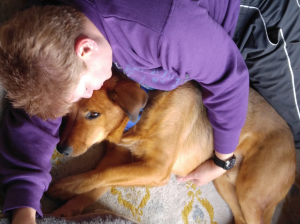By Rhonda York

Prison program-trained dog is well-mannered, knows all the basic cues, has excellent recall and does not pull on the leash © Rhonda York
One of the many things I get to do as a dog trainer is train inmates at the Federal Penitentiary in Leavenworth, Kansas in tandem with the Leavenworth County Humane Society.
It helps both the residents and dogs and we work together to train the dogs in the program to have good manners and basic skills.
Last November, one of the dogs, Blake, had finished his training but hadn’t been adopted yet.
I didn’t want him to go back to the shelter, so knowing he should be able to get along with my other dogs, I decided to foster him until he got adopted. Well, it certainly worked, as my family adopted him!
Benefits of Adopting a Dog Trained through a Prison Program
I would like to share here what I have found to be some of the benefits of adopting a dog that has been trained through a prison program. For starters, I did have to work on some extra reinforcing of a couple of cues because he was in a totally different environment. Dogs don’t generalize well, so they have to be taught that the cues they know in one place apply to a different place. And since I used the same cues as those he already knew, it was incredibly easy.
Blake is well-mannered, knows to wait, sit, down, stay, stop, and turn. He doesn’t pull on his leash and his recall is such that I trust him off-leash. I’ve only had to practice with him a couple of times to know he is ready to take the Canine Good Citizen test in any environment. I am also training him to be a therapy dog at which I know he will excel.
Training a Dog for Basic Manners
Having trained my other dogs from the beginning and helped others train their dogs for basic manners, this was truly the most straightforward I’ve ever experienced.
If you are interested in adopting a dog that you don’t have to train yourself, I believe adopting a dog who has been though a prison training program is a good option. While you still have to keep working on the cues so that the dog will continue responding to them, as you would with any dog, the residents will already have done a great job in getting the dog ready to be in a home.
*This post is an entry in our Phoenix 2020 Writers’ Competition. All winning, runner up and selected entries are being published here on the BARKS Blog. For a fully immersive educational experience in animal sheltering and rescue, join us at the Pet Professional Guild Annual Summit in Phoenix, Arizona on September 17-21, 2021.*
About the Author
Rhonda York is the owner/operator of Dog Training with Rhonda York in Leavenworth, Kansas. After careers as a professional singer, voice teacher, and clergy, she decided it was time to train dogs and their humans, the catalyst for which was when she was volunteering at the PAWS Animal Shelter in Pueblo, Colorado and saw the difference she could make in the life of a dog. She did her certification training through Animal Behavior College and is a member of the Leavenworth Animal Welfare Society, Human Animal Bond, and the Leavenworth County Humane Society.
